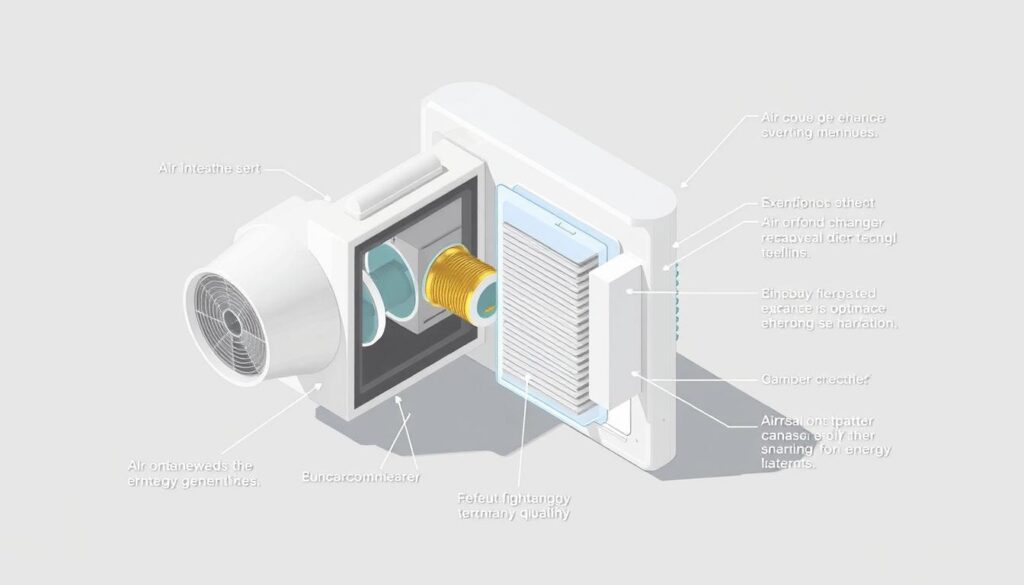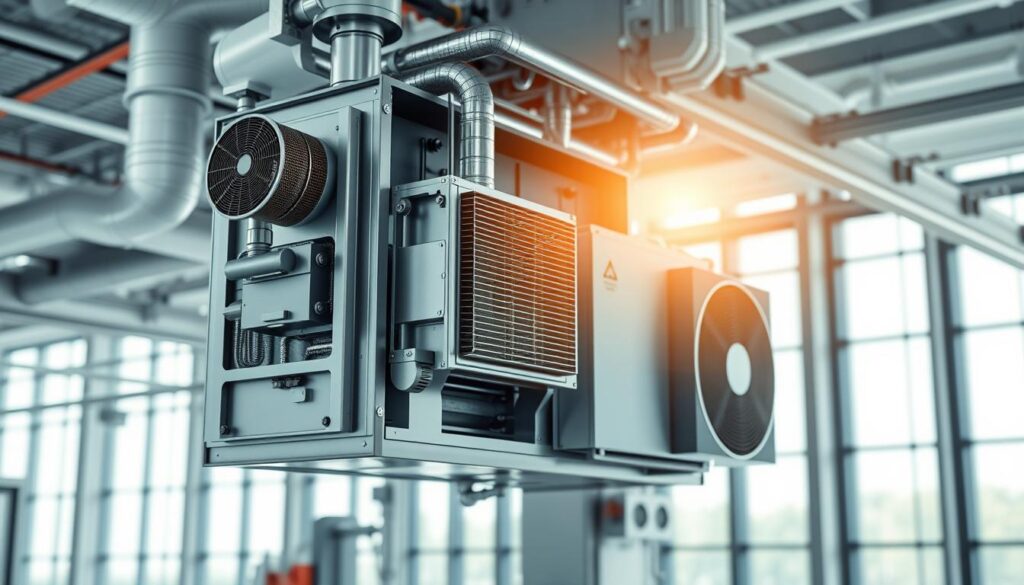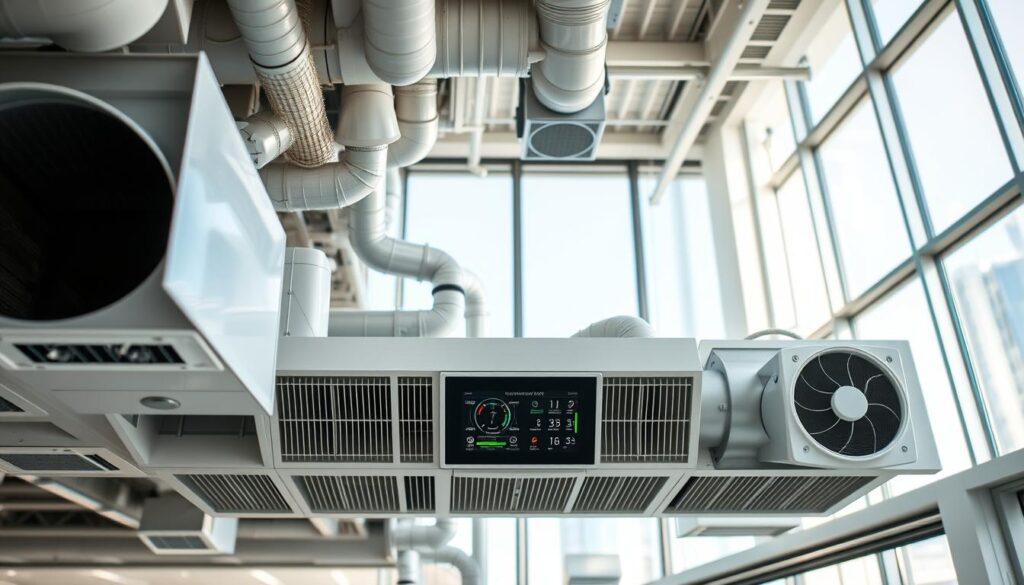Affiliate Disclosure
HVAC Guide Guys is a participant in the Amazon Services LLC Associates Program, an affiliate advertising program designed to provide a means for sites to earn advertising fees by advertising and linking to Amazon.
What is an Economizer for HVAC? An HVAC economizer is a cutting-edge tech that lowers energy costs for commercial buildings. It uses cool outside air to cool your space, a smarter way than old mechanical systems.

Are you fed up with high energy bills and inefficient cooling? There’s a smart way to cut down your building’s energy use while keeping it comfy inside.
Learning about HVAC economizers changes how you see climate control in buildings. These smart systems use outside air for cooling when it’s cool enough, saving on energy costs.
Key Takeaways
- HVAC economizers can significantly reduce energy consumption
- They utilize free cooling from outdoor air when conditions are favorable
- Economizers integrate seamlessly with existing HVAC systems
- Potential for substantial cost savings in commercial buildings
- Supports improved indoor air quality and environmental sustainability
Table of Contents
Understanding HVAC Economizer Basics
An HVAC economizer is a smart system that makes buildings more energy efficient. It controls air to cut down cooling costs and boost system performance. Knowing how it works can lead to big energy savings for building owners.
Economizers manage air in buildings in a smart way. They use outdoor air to cool spaces when it’s possible. This lessens the need for mechanical cooling.
Key Components of an Economizer System
- Motorized dampers for air intake and exhaust
- Temperature and humidity sensors
- Electronic controllers
- Actuators for precise damper positioning
- Air filters to ensure clean incoming air
Integration with HVAC Systems
Economizers work well with existing HVAC systems. They use smart temperature control. They watch indoor and outdoor air to find the best cooling method.
| Component | Primary Function | Energy Impact |
|---|---|---|
| Dampers | Control air flow | Reduce mechanical cooling needs |
| Sensors | Measure temperature/humidity | Optimize air intake decisions |
| Controllers | Manage system operations | Maximize energy efficiency |
Operating Principles and Control Mechanisms
The control system of an economizer is very smart. It looks at many things like temperature, humidity, and air quality to decide the best cooling method.
“An intelligent economizer can reduce cooling energy consumption by up to 75% during moderate weather conditions.” – HVAC Energy Efficiency Research Institute
By knowing how economizers work, building managers can make their climate control better and cheaper.
What is an Economizer for HVAC
An HVAC economizer is a smart device that saves energy by using outside air when it’s cool. It makes your building cooler without using as much energy. This system boosts your HVAC’s performance and cuts down on energy use.
This device brings in cool outside air instead of cooling indoor air. When it’s cooler outside than inside, it switches to outside air. This saves a lot of energy for your building.
- Reduces mechanical cooling requirements
- Minimizes energy consumption
- Improves overall HVAC system efficiency
- Provides enhanced indoor air quality
Economizers work best in areas with mild weather. They can cut your cooling costs by 30% to 60% every year.
“An economizer transforms traditional HVAC systems into smart, energy-efficient solutions that adapt to changing environmental conditions.”
There are different types of economizers, like air-side and water-side systems. Each is designed for specific buildings and places. Your choice depends on your building’s needs and where you are.
Types of HVAC Economizers and Their Applications
Commercial HVAC economizers are advanced energy-saving tools. They help buildings use less energy for heating and cooling. There are different types, each for specific needs.
Knowing about the various economizers can help you choose the best one for your building. Let’s look at the main types used in commercial HVAC systems today.
Air-Side Economizers
Air-side economizers are the most common. They bring in outside air when it’s cooler than inside. This cuts down on the need for mechanical cooling.
- Ideal for buildings with moderate climate conditions
- Can significantly reduce energy consumption
- Best suited for office buildings and commercial spaces
Water-Side Economizers
Water-side economizers cool the building’s water loop in new ways. They use cooling towers or fluid coolers. This is more efficient than traditional cooling methods.
- Effective in data centers and large industrial facilities
- Utilizes natural cooling resources
- Reduces overall energy expenditure
Differential Enthalpy Systems
Differential enthalpy systems are the most advanced. They compare indoor and outdoor air to find the best cooling method. This is the most energy-efficient way.
| Economizer Type | Best Application | Energy Savings |
|---|---|---|
| Air-Side | Office Buildings | 30-40% |
| Water-Side | Data Centers | 40-50% |
| Differential Enthalpy | Complex Facilities | 50-60% |
Choosing the right economizer depends on your building, climate, and energy goals. Talking to HVAC experts can guide you to the best choice for your space.
Explore Our HVAC Shop
Looking for top-rated HVAC tools, parts, and accessories? Visit our shop and find the perfect solution for your needs.
Visit the ShopExplore Our HVAC Shop
Looking for top-rated HVAC tools, parts, and accessories? Visit our shop and find the perfect solution for your needs.
Visit the ShopEnergy Savings and Cost Benefits

Economizer energy savings are a key way to cut costs in commercial and industrial buildings. Free cooling with economizers can greatly reduce energy bills and boost efficiency.
Getting an economizer system brings big financial gains. Most buildings see a payback in one to three years, based on energy costs and climate. The long-term benefits are huge.
- Reduce mechanical cooling energy consumption by up to 60%
- Lower annual HVAC operating costs
- Minimize carbon footprint
- Improve overall system performance
Free cooling with economizers uses outside air when it’s cool. This lets your HVAC system get cool air without needing to use a lot of energy. This leads to big savings every year.
Smart building managers can save thousands of dollars annually by implementing economizer technologies.
Your savings will depend on a few things:
- Geographic location and climate
- Building size and usage
- Current HVAC system efficiency
- Hours of operation
Using economizers smartly can change your building’s energy use. You’ll see big financial gains.
Installation Requirements and Considerations
Installing an HVAC economizer needs careful planning. Your building’s unique features are key to finding the best solution. The right choice can boost energy efficiency and cut costs.
When looking at economizer installation, several important factors come into play:
Building Compatibility Assessment
Not every building is right for an economizer. You’ll need to check:
- Existing HVAC setup
- Building design and layout
- Age and state of current systems
- Ventilation options
Climate and Weather Impact
Your local climate greatly affects how well an economizer works. Places with mild temperatures and low humidity get the most benefit.
System Sizing Guidelines
Getting the system size just right is key. A too-small economizer won’t save much energy. But a too-large one adds too much complexity.
Here are some tips for sizing:
- Look at your building’s total square footage
- Figure out your peak cooling and ventilation needs
- Consider how many people usually occupy the space
- Get a certified HVAC pro to measure accurately
Pro tip: Always work with certified HVAC professionals to ensure optimal economizer installation and long-term performance.
Explore Our HVAC Shop
Looking for top-rated HVAC tools, parts, and accessories? Visit our shop and find the perfect solution for your needs.
Visit the ShopHow Economizers Impact Indoor Air Quality

HVAC economizer systems are key to better indoor air quality and energy savings. They manage air flow, temperature, and ventilation better than old HVAC systems.
Economizer controls in buildings offer many benefits for a healthy indoor space:
- Improved air circulation and ventilation
- Reduced indoor pollutant concentrations
- Dynamic air quality management
- Enhanced temperature and humidity control
Using HVAC economizers can do more than save energy. They filter and manage outdoor air, making sure your space gets fresh air. This is very important in cities with more pollution.
| Air Quality Parameter | Economizer Impact |
|---|---|
| Temperature Regulation | Precise outdoor air mixing |
| Humidity Control | Intelligent moisture management |
| Particulate Filtration | Advanced air screening mechanisms |
By adding advanced economizer tech, you can make indoor spaces healthier. This also helps meet green building standards like LEED and ENERGY STAR. These systems are a smart choice for better building performance and health.
Maintenance and Performance Optimization
Keeping your HVAC economizer in top shape is key for the best performance and energy use. Regular upkeep stops sudden failures and makes your HVAC last longer.
Effective maintenance includes several important steps:
- Do visual checks on economizer parts every quarter
- Make sure sensors are working right
- Check if dampers work well and seals are tight
- Change or clean air filters
- Oil moving parts
Your upkeep plan should cover both simple and detailed checks. Seasonal changes can really affect how well an economizer works. So, it’s important to keep an eye on it all the time.
| Maintenance Task | Frequency | Key Focus Areas |
|---|---|---|
| Visual Inspection | Quarterly | Damper condition, mechanical wear |
| Sensor Calibration | Annually | Temperature, humidity accuracy |
| Filter Maintenance | Every 3-6 months | Air quality, system efficiency |
Advanced diagnostic tools are great for finding problems early. Think about using digital monitoring systems. They give you live updates and tell you when you need to do maintenance.
Proactive maintenance is always more cost-effective than reactive repairs.
By taking the time for regular maintenance, you’ll save energy, make your system more reliable, and extend its life. It’s a smart investment for your HVAC economizer.
Explore Our HVAC Shop
Looking for top-rated HVAC tools, parts, and accessories? Visit our shop and find the perfect solution for your needs.
Visit the ShopCommon Applications and Success Stories
Commercial HVAC economizers have changed the game for energy efficiency in many industries. These systems offer free cooling, changing how businesses manage temperature and use energy.
Real-world examples show how versatile these systems are. Companies have seen big benefits by using these smart cooling solutions.
Data Center Cooling Innovations
Tech giants are at the forefront of using economizers. Here are some amazing examples:
- Google’s Belgium data center uses only outside air for cooling.
- Microsoft’s Dublin facility uses economizers to cool servers up to 95 degrees.
- Yahoo’s “chicken coop” data center in upstate New York cools with outdoor air.
Commercial Building Success
Office buildings, schools, and malls are using commercial HVAC economizers to:
- Save on energy costs
- Lower operational expenses
- Reduce environmental impact
- Boost building efficiency
Industrial Facility Implementations
Manufacturing and industrial sites are seeing big benefits with free cooling economizers. By integrating these systems, companies can save a lot on energy and improve environmental control.
Modern economizer technologies are a big step forward in sustainable building management and energy efficiency.
Conclusion
Learning about economizers for HVAC shows a smart way to cut down on energy use in big buildings. These systems are key for companies wanting to save money on cooling costs. They help make buildings more energy-efficient.
Economizers do more than just control temperature. They use outside air to cool buildings in a smart way. This can lead to big savings on electricity bills. Buildings that use economizers well can save a lot of money.
When thinking about HVAC efficiency, consider using economizers. Today’s buildings need smart solutions that save money and are good for the planet. Economizers are a great choice for making buildings cooler and greener.
With stricter environmental rules and higher energy prices, it’s smart to invest in new HVAC tech like economizers. Choosing advanced cooling systems helps make buildings better for the environment and saves money. This way, you can meet today’s and tomorrow’s building standards.

